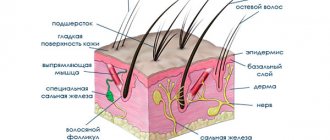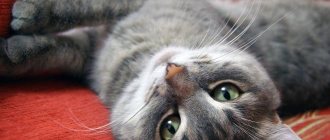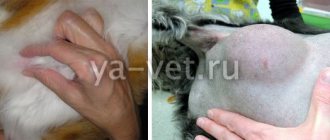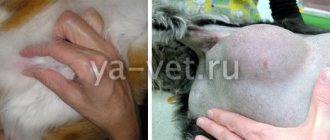Mastitis in cats is a bacterial infection that affects the mammary glands.
Mastitis in cats can be a very painful condition, although most of the time it is not considered an emergency. This process is almost always localized in the tissues of the mammary glands, but if it becomes severe, it can spread to other parts of your cat’s body and become septic. That is, a bacterial infection develops that affects your cat’s blood.
The mammary glands consist of lobes of alveoli with a system of ducts that transport milk in the female cat to the external nipple.
These glands usually occur in pairs and begin secreting milk immediately after the birth of the litter.
How mastitis attacks cats
The infectious process can develop in only one gland, or affect several glands. The disease can also occur as a result of trauma from litter, due to bites, or as a result of the spread of infections from other sites through the blood system, especially in older or geriatric cats.
If mastitis is localized to only one gland, the cat may not show any symptoms or signs of the disease at all. However, if it spreads and affects multiple glands, the cat may show signs of anxiety, malaise, or serious illness. For this reason, your breasts should be checked daily.
If the mammary glands feel hot, hard, and painful to your nursing cat, they are likely infected.
It would be a good idea to check the milk every day as well. And if the milk changes color or begins to thicken, this indicates that it is contaminated with bacteria.
Classification of mastitis
Based on the nature of the inflammatory process, mastitis is divided into several types, each of which has its own clinical picture.
Serous
It is characterized by active hyperthermia of one or more mammary glands, the release of serous exudate (opaque liquid) from the nipples. Most often it occurs in the first days after birth due to injuries to the nipples, hypothermia of the cat, and stagnation of milk in the mammary glands. Pathology can also develop under the influence of streptococci and staphylococci, which the animal can become infected with.
Catarrhal
Inflammation usually develops in the milk ducts and alveoli, as a complication that spreads from the skin of the nipples. Only the glandular tissue of the mammary gland is affected. The clinic resembles the serous form of the pathology. The main cause of catarrhal mastitis is considered to be unsanitary conditions.
Purulent
This type of pathology leads to a decrease or complete disappearance of lactation. Characterized by purulent discharge from the nipples. The cat's mammary glands are very hyperemic, the skin around the nipples is red. The abscess area is painful. The animal experiences intoxication and seeks to stop contact with humans and offspring. After this pathology, cats may completely lose the ability to feed kittens.
Fibrinous
Occurs after abortion, delayed placenta, diseases of the uterus and purulent processes in the cat’s genitals. Most often it is a complication of serous and catarrhal mastitis. This type of pathology occurs quickly and severely. The animal's temperature rises to 41°C. The cat is severely intoxicated.
Hemorrhagic
A dangerous form of pathology. Most often it occurs in the first days after childbirth, as a complication of serous and catarrhal mastitis. The cat's mammary gland tissue becomes covered with numerous hemorrhages. The animal's temperature rises to 41°C. The cat is depressed, the glands are very painful. Bleeding is possible. After treatment, the mammary glands may lose their functions.
Gangrenous
Occurs in the absence of treatment for other forms of mastitis. Most often, cats that are in poor sanitary conditions get sick. It is characterized by necrosis (death) of the affected breast tissue. The cat's temperature rises sharply (above 41°C) or also drops sharply. The animal is immobilized. Possible death.
Symptoms of mastitis in cats
In addition to checking the volume of glands or the quality of milk, you can observe several other symptoms of mastitis in cats.
When checking the glands, it is important to make sure that they are not hot or hard, and you also need to pay attention to the presence of swelling. This symptom becomes obvious before the gland actually becomes painful for the cat.
Reddening of the nipples will also begin before they become painful. This usually follows shortly after the milk becomes discolored and discharge from the glands appears.
If there is discharge, then the next symptom you can watch for is an abscess.
This is a particularly dangerous symptom because the abscess can easily rupture and cause the infection to spread to other parts of your cat's body.
Sudden fever is another sign to look out for.
However, perhaps the two most obvious signs that the infection has become serious will be the kittens, which will then become chronically crying or sick.
These symptoms should be taken very seriously as they can easily lead to the death of the newborn litter.
Symptoms of the disease
It is very difficult to notice this disease at an early stage, especially if the animal has thick fluffy hair. The reason for a close examination is anxiety or refusal to feed the kittens.
Signs of mastitis:
- The mammary gland becomes hard to the touch and increases in size;
- The skin around the nipples turns red and its temperature rises;
- Cracks appear in the skin around the nipples;
- The animal avoids any touching of the nipples, as during this it experiences pain;
- The presence of blood or pus discharge from the nipples;
- The presence of discharge in the form of a curd mass from the nipples;
- General weakness and apathy;
- Increased body temperature;
- Poor appetite or complete refusal to eat.
If you have one or more of the above symptoms, you should contact your veterinarian to determine the stage of the disease and prescribe treatment.
Diagnostics
The owner can carry out the initial examination of the animal independently; special attention should be paid to the size and color of the nipples, as well as the nature of the discharge. If symptoms occur, it is recommended that you contact your veterinarian for a milk test.
Treatment of mastitis in cats
There are several different forms of treatment for mastitis in cats, and the choice of treatment will depend on the severity of the infection.
The first form of treatment for mastitis is antibiotic therapy. Which type of antibiotic to choose will depend on the pH tests of the cat's milk. This is extremely important for the effective treatment of this disease. Cat milk pH measures the acidity or alkalinity of the milk and is measured between 0 and 14. The neutral number is generally considered to be 7.0, but cat milk pH levels generally fall between 6.6 and 6.9. If the acidity is 7.0 or higher, then it is a risk. If your cat is fed milk that has a pH higher than 7.0, it can be toxic to the litter and may also contribute to the development of mastitis. Once your veterinarian has determined this level, antibiotics are usually given by the owner unless the infection is severe. Otherwise, they will be administered intravenously. Until the pH level has been reduced to a safe level, it may be advisable to feed the litter milk replacers.
A warm water compress helps drain the infected area and clear it of fluid. It is very important to make sure that the compress is warm and not hot. Until the fluid is properly drained, if you choose not to use milk replacer, hand milking may also be a form of treatment for mastitis in cats.
In most but the most severe cases, warm compress therapy will serve two purposes.
Firstly, it will help improve blood circulation in the breast area, and also facilitate the effective penetration of antibiotics into infected tissues.
If an abscess occurs, surgical treatment is required. This type of treatment must be carried out and supervised by your veterinarian as it requires special conditions, skills, and knowledge and experience. Monitoring is essential because if the infection is not completely eradicated, the abscess may have to be drained again until it is completely removed.
If this infection has spread significantly and has already caused tissue necrosis, the only effective treatment may be a mastectomy (removal of the breast). However, this form of treatment is extremely rare.
If the veterinarian notes that the infection has become very severe, causing sepsis, then this means that it has spread throughout the body, and then the form of treatment will be intravenous infusion therapy.
This can be very expensive and may take several days for your cat to recover. However, in most cases they are completely restored.
An important part of treating mastitis in nursing cats is to weigh the litter every day. If the treatments are effective, they will show up on the kittens' weight as they receive healthy and essential nutrients for their bodies.
Disease prevention
Timely implementation of preventive measures will help prevent the development of the disease and protect your pet from unpleasant symptoms.
Prevention methods for mastitis:
- Timely vaccination.
- Treatment of animal fur with antiparasitic agents. Since fleas cause severe itching, the cat can injure the mammary glands in the process of scratching, which contributes to the development of bacteria and infections.
- Selecting the right diet for a nursing cat, which does not contain products that affect the increase in milk supply.
- Providing the cat with satisfactory living conditions, a clean potty and bedding.
- Minimizing the risk of hypothermia or injury to the cat.
- Treatment of wounds and cracks on the nipples with a solution of potassium permanganate.
- Regular cat examinations.
- Expressing if kittens do not drink all the milk.
If you take care of your pet’s hygiene, diet, and regularly conduct examinations at the veterinarian, its mammary glands will not become inflamed. It should be remembered that preventing the development of mastitis is much easier than treating it. This will protect both the cat and kittens and their owners from unpleasant consequences.
Clinical case of treatment of mastitis in a cat
A 9-month-old patient was admitted to the Department of Endoscopic Surgery and Veterinary Diagnostics with a diagnosis of fibroadenomatous hyperplasia of the mammary glands for surgical removal of the ovaries, with minimal tissue trauma (laparoscopic oophorectomy), since the healing of the surgical wound in such patients often occurs with complications.
The operation was performed by a surgeon at the veterinary endoscopic department. There were no complications during the recovery period. Due to a decrease in hormonal load, a decrease in the volume of the mammary glands is observed.
Therapy first aid and treatment
In the initial stages, self-help for a cat with mastitis is acceptable, but in the future, at least a small intervention from a specialist is highly desirable. So, if the nipples are just a little swollen and red, but milk is coming out and the temperature is normal, try emptying your cat's mammary gland of stagnant milk.
Note! To do this, you can either bring the kitten to the sore nipple, or express milk using gentle pressure on the sore organ. Too strong, sharp touch can play a negative role. If you are worried that you won’t do everything carefully, invite someone who has experience. Not only a veterinarian can help here, but also an acquaintance, friend or neighbor - those who have encountered a similar problem with their cat.
Keep in mind that... ... Warm compresses sometimes help, but they can also cause harm. The fact is that heat is a good environment for the growth of bacteria. Therefore, lotions made from gauze soaked in a decoction of chamomile, sage or oak bark with a temperature of about 38 degrees can help much better. Sometimes a little cooling works even better. All you have to do is apply the cabbage leaf for 5 minutes, then turn it over and apply it for approximately the same time.
If you find out that you are producing too much milk , proceed as follows:
Tags
Diagnosis of mastitis in Mastitis Causes of mastitis types of mastitis Purulent mastitis diagnosis of mastitis dangerous mastitis Treatment of mastitis Treatment of mastitis in cats with mastitis in CATS Io cats about cats mastitis cats in the milk of a cat in a cat in a cat contributes to the cat's pain. .in cats, lactating cats and in cats, cats are classified as cats, characterized in cats. In cats, otodectosis. Signs of the disease are dairy urological diseases. the form of the disease is noted, the onset of the disease may the course of the disease requires
dogsbreedsarticlerodentswill be diagnosticcatbirds
We make an accurate diagnosis:
At the earliest stage, mastitis “behaves” secretly and quietly; it is completely impossible to notice it with the naked eye on your own. If you miss this time and start the disease, the cat’s health is in great danger. That is why it is so important to make an accurate diagnosis in time, identifying the reasons for which the disease arose.
Timely treatment depends on the pet owner. It is he who must carefully monitor the condition of the pregnant cat, then keep an eye on her, figuratively speaking, during the period of feeding the kittens and after the cubs are weaned from mother's milk, switching to regular food. The listed time is very dangerous in terms of mastitis for the mother cat. Having noticed at least one of the previously listed symptoms
, for example, fever, loss of appetite, lethargy, you must
call a veterinarian
to examine the animal.
By calling our emergency veterinary service and making a home call, a veterinary specialist will arrive at your place within 40 minutes with all the necessary documents and equipment. During the examination, he will ask when the kitten gave birth, whether there were any complications during pregnancy and birth, when the kittens were weaned, etc., related to this topic.
If the owner's suspicions are confirmed, tests will be carried out. Your veterinarian will conduct laboratory tests on nipple discharge. In this case, it becomes possible to determine the cause of mastitis. If this is the fault of bacteria, then the course of treatment will be completely different from that for mastitis caused by a fungal infection. An incorrect diagnosis and, as a result, incorrectly prescribed treatment can cause irreparable damage to the health of a four-legged patient.











